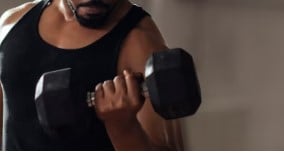Useful arm exercises for everyday strength

What you need to know:
- Arm exercises are crucial for several reasons, impacting not only physical health but also day-to-day functionality. They are also beneficial for many
Everyday arm exercises are your secret weapon for strength, agility, and functional wellness. Just a few minutes a day can bring transformative benefits, helping you lift, carry, and reach with greater ease. Imagine carrying heavy bags or lifting items overhead without a second thought, strong arms make all of this feel effortless.
Not only will your muscles feel more defined, but you will notice better posture and reduced strain on your back and shoulders. Plus, strong arms contribute to overall joint stability, protecting you from injuries in daily life.
When it comes to fitness, many men prioritise arm workouts to achieve a muscular, sculpted look. Strong arms are often seen as symbols of strength and aesthetic appeal, which is why exercises such as bicep curls and triceps dips feature so prominently in many routines. However, the importance of arm strength extends far beyond appearance.
Arms play a crucial role in almost every movement, from lifting objects to other everyday tasks. As we age, arm strength naturally declines, making daily activities more challenging and increasing the risk of injury.
Why arm exercises?
According to health.harvard.edu, arm strength and overall muscle mass start to decline by one percent per year around age 35, and by age 60, we can lose up to three percent of our muscle mass annually. This highlights why incorporating arm exercises into your routine is not just about looking good; it is about maintaining functionality and overall well-being. Regular strength training can help preserve and even enhance arm strength, helping us stay agile and capable.
Henry Ssebwami, a personal trainer, says the triceps anbiceps are essential muscles that play a key role in performing everyday tasks. Their main functions include lifting, carrying, and manipulating objects.
The triceps, located on the back of the upper arm, originate from the shoulder blade, or scapula, and are responsible for straightening the arm at the elbow joint. They are used for pushing, lifting, and throwing. While bicep curls and tricep extensions are classic exercises for building arm strength, they target individual muscles rather than providing the functional strength needed for everyday activities.
To build functional strength, it is best to include exercises that target multiple muscle groups, not just the arm muscles. Functional arm exercises often incorporate the shoulders, rotator cuff, back, and chest muscles, which are all essential for heavy lifting and other upper body strength tasks. Here are some arm exercises and how to perform them:
Bicep curls
Stand tall with feet shoulder-width apart, chest lifted, and back straight. Hold a dumbbell in each hand with your arms at your sides, palms facing forward. Slowly bend your elbows, lifting the dumbbells toward your shoulders. Pause briefly, then lower them back to the starting position.
Overhead press
Sit on the edge of a sturdy chair with knees bent and heels on the floor. Grip the chair firmly with hands beside your hips. Press down to lift your hips off the seat, moving forward so that you are clear of the chair's edge.
Bend your elbows to lower your hips toward the floor until they form a 90-degree angle, keeping your back close to the chair. Pause briefly, then straighten your arms to return to the starting position, exhaling as you do.
Bent-over row
Stand with a weight in your right hand and a bench or sturdy chair on your left. Place your left hand and knee on the bench. With your right hand extended downward, squeeze your shoulder blades together, then bend your elbow to lift the weight toward your ribs, keeping it close to your side. Exhale as you lift, then return to the starting position. Repeat on the other side for a full set.
Kneeling push-up
Start on all fours with hands shoulder-width apart. Tighten your abs, keeping your head in line with your spine. Walk your hands forward and lower your hips, forming a straight line from head to knees.
Slowly lower your upper body toward the floor, bending your elbows out to the sides until they form a 90-degree angle. Pause briefly, then press against the floor to return to the starting position.
TRAINING TIPS
“When strength training, aim for eight to 12 repetitions (reps) of each exercise,” explains Henry Ssebwami, a personal trainer. “If you cannot complete all the reps initially, do what you can and gradually increase as you improve.” Beginners can start with one set per side, working up to three sets as strength builds. Rest for 30 to 90 seconds between sets. If the exercise requires equipment, start with light weights, increasing weight as you progress. If you do not have weights, use bottles or cans filled with water, or perform the exercises without weights initially.




